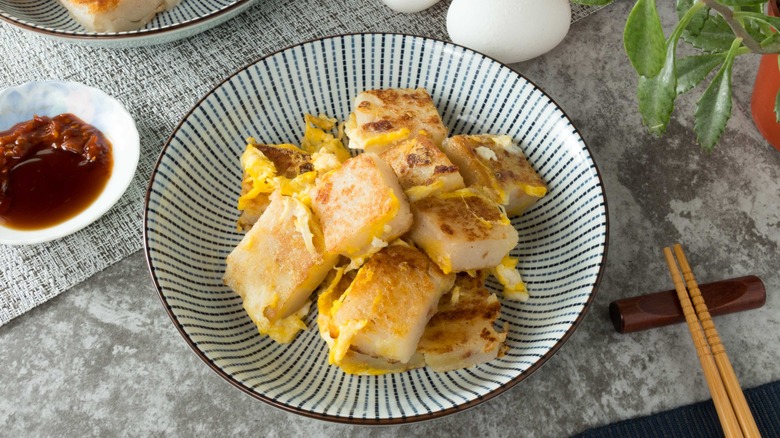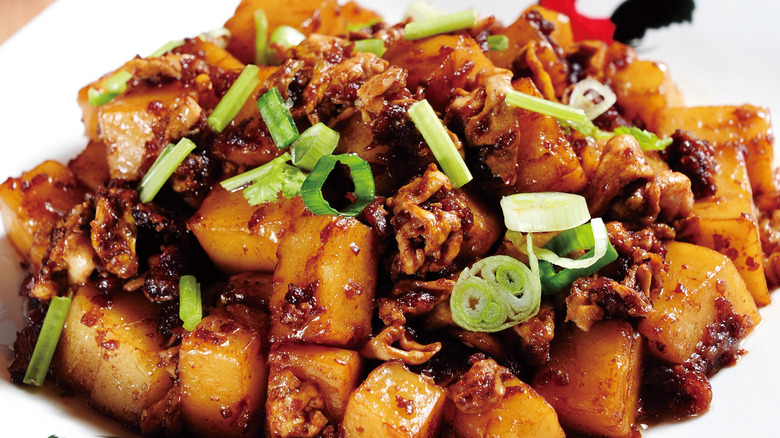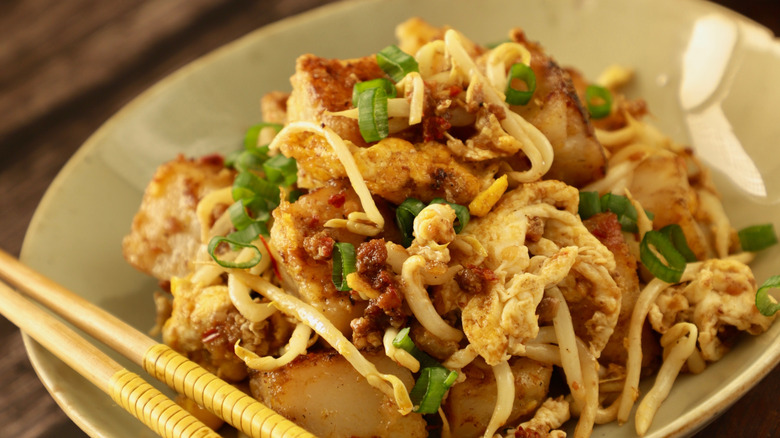You Might Get Confused If You Order Carrot Cake In Singapore
When most people think of carrot cake, they probably picture sweet, dense, carrot-laden dessert cakes frosted with cream cheese icing and perhaps decorated with a little icing carrot on top. However, if you find yourself in Singapore and order a carrot cake, you might be in for a bit of a shock when your plate arrives.
Singapore carrot cake, known locally as chai tow kway, isn't a dessert at all. It doesn't even have carrots in it. Rather, it's a savory dish made of rice flour and daikon radish (which is also known as a white carrot,) that is steamed, chopped into cubes, and then fried with egg and other mix-ins in a wok. The result is more reminiscent of a stir fry or an omelet than the carrotty, sugary confection most people in the United States are used to.
Although those are the basics of Singapore carrot cake, the exact ingredients in it are a little more nuanced. Plus, it's got an interesting backstory that can also help unlock some of the mysteries of why this dish is called what it is.
If not carrots, what's in Singapore carrot cake?
Before exploring what goes into Singapore carrot cake, it's important to know that there are two versions — black, and white. Both have similar ingredients, but there are a couple of distinct differences you should know about.
The white Singapore carrot cake is made of a steamed rice flour cake with white daikon radish mixed into it. The cake is chopped into cubes and fried with eggs and often with mix-ins including garlic and preserved vegetables. It is seasoned with fish sauce or light soy sauce and served with hot chili sauce and chopped scallions. White Singapore carrot cake tastes salty and eggy and can have a bite to it, thanks to the chili sauce.
Black chai tow kway is made a little differently. Although black Singapore carrot cake uses the same ingredients and cooking methods as white carrot cake, it is seasoned with a dark, sweet soy sauce instead of light soy or fish sauce. The dark soy sauce is what gives black Singapore carrot cake its distinctive appearance and sweet, caramelized flavor.
Why is it called Singapore carrot cake if it doesn't have carrots?
To better understand the nuances of Singapore carrot cake, it helps to know a bit about its origins. The dish is said to have originated in Southern China, and was brought to Singapore by Teochew immigrants sometime in the 1800s. The meal was originally made by frying rice cake cubes with soy sauce. Eventually, the meal evolved into "black" and "white" versions, and is now a popular meal sold by street hawkers in Singapore.
There is still a lot of debate over who invented the modern versions of Singapore fried carrot cake. In the 1960s, Teochew hawker Ng Soik Theng, claimed credit for adding white radish to the rice flour cakes and renaming the dish chai tow kway. Meanwhile, hawker Lau Goh claimed to be the first person to use light soy sauce instead of dark soy sauce, and many other hawkers have also claimed to have popularized or created new versions of the meal.
Regardless of who first came up with modern versions of Singapore carrot cake, the savory radish dish is enjoyed throughout Singapore, Malaysia, Taiwan, and other Southeast Asian countries. If you ever find yourself in that corner of the world, toss your conventional ideas of carrot cake with creamed cheese frosting right out the window and give this dish a try.


